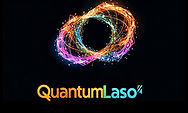Quantum Coffee Break: Discovering the Variational Entanglement Witness Algorithm
- mansour ansari

- Mar 30
- 2 min read

Today, as I enjoyed my coffee, I stumbled upon another quantum computing breakthrough—this time, an innovative algorithm named the Variational Entanglement Witness (VEW). Developed recently, VEW empowers quantum computers to efficiently detect and measure their own entanglement, significantly accelerating tasks previously challenging even for classical supercomputers.
This intriguing discovery comes right on the heels of two other fascinating developments I've been tracking closely:
Semantic Quantum Communication, where entangled photons and photon polarization patterns encode emotions directly, paving the way for a richer quantum-based communication method. It means my approach to building a quantum linguistic foundation is validated by more advanced quantum research companies.
Hidden Codes of Quantum Entanglement, where scientists (See the link I have included below) decoded complex entanglement patterns, demonstrating how powerful and practical quantum pattern analysis can be in real-world scenarios.
As I see this, and as I said, each of these recent advancements strongly validates my own research with Zaban-e-Quantum, a quantum linguistic framework that leverages quantum entanglement patterns—captured through ion trapping and annealing quantum machines—to build a dictionary and, eventually, a robust quantum-native language.
The VEW algorithm specifically offers an exciting advantage. It provides a powerful hybrid quantum-classical method, making quantum computers themselves capable of verifying entanglement directly on-chip. Here’s how it works in brief:
Quantum hardware prepares parameterized quantum states.
It then measures these states using specially designed entanglement witness operators, generating expectation values.
A classical optimization loop (like gradient descent or Bayesian optimization) then tunes the quantum circuit parameters to minimize the expectation values, clearly distinguishing entangled from non-entangled states.
Implementing my own customized version of VEW within the Zaban-e-Quantum project could profoundly enhance efficiency by speeding up the identification and extraction of high-quality entanglement patterns. This means my quantum dictionary—constructed from millions of quantum iterations—would benefit immensely from VEW by rapidly isolating the most valuable entanglement data before sending it through classical noise-reduction stages (like my new NVIDIA Jetson Nano project) and advanced AI (CNN and RNN) for pattern classification and language mapping.
This hybrid workflow maximizes quantum computational resources while streamlining the classical AI pipeline, substantially accelerating the dictionary construction and prototype phase. I have a clear target; by the end of this year or earlier, based on my focused time, I will have created - I hope - the basics of my quantum dictionary. Ultimately, this approach moves me significantly closer to realizing the vision of Zaban-e-quantum : a quantum-secure linguistic framework capable of not just secure communication but perhaps even decoding signals from beyond our solar system.
Time to brew another cup and get back to work—quantum computing doesn’t wait!
#QuantumComputing #QuantumEntanglement #VariationalEntanglementWitness #QuantumAlgorithms #ZabanQuantum #QuantumAI #QuantumDictionary #QuantumLaso #QuantumInnovation #FutureTech #Research

link :





Comments